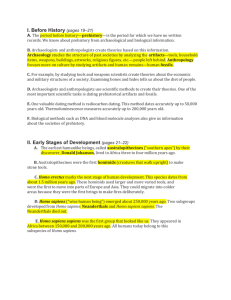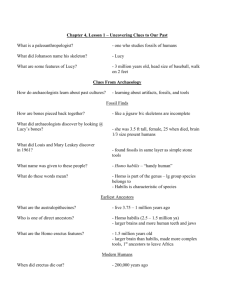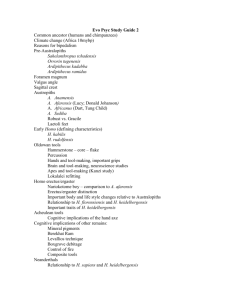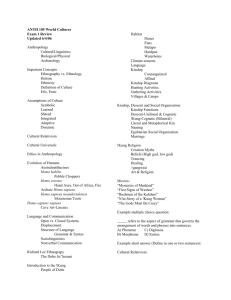Neanderthals and Other Archaic Homo sapiens
advertisement
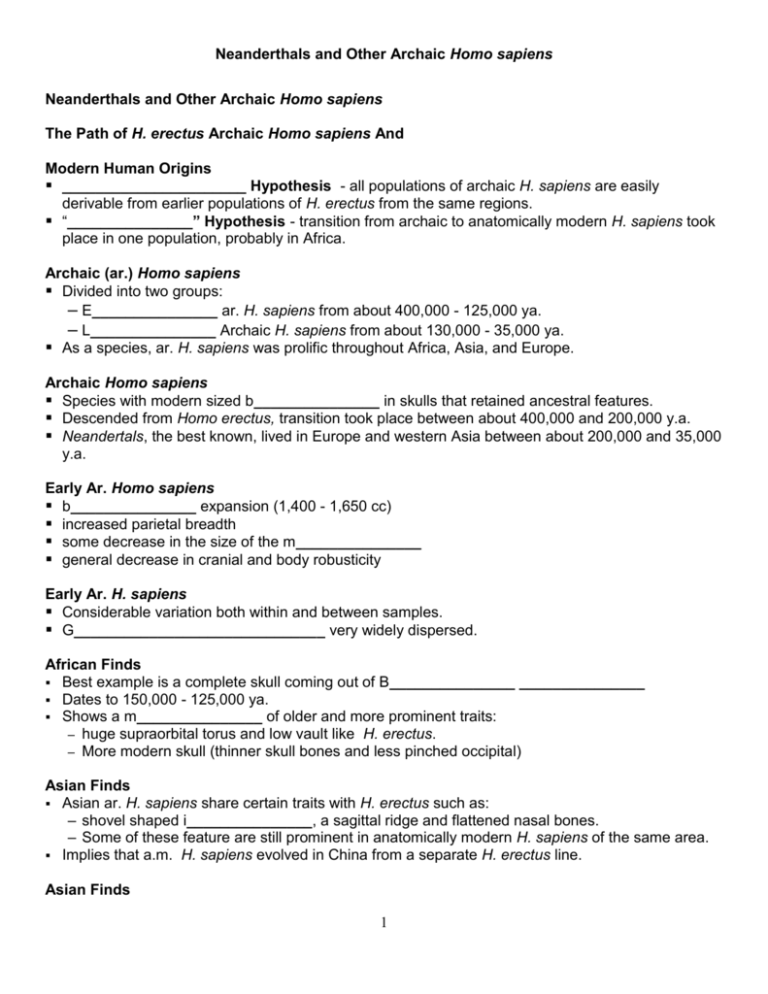
Neanderthals and Other Archaic Homo sapiens Neanderthals and Other Archaic Homo sapiens The Path of H. erectus Archaic Homo sapiens And Modern Human Origins ______________________ Hypothesis - all populations of archaic H. sapiens are easily derivable from earlier populations of H. erectus from the same regions. “_______________” Hypothesis - transition from archaic to anatomically modern H. sapiens took place in one population, probably in Africa. Archaic (ar.) Homo sapiens Divided into two groups: – E_______________ ar. H. sapiens from about 400,000 - 125,000 ya. – L_______________ Archaic H. sapiens from about 130,000 - 35,000 ya. As a species, ar. H. sapiens was prolific throughout Africa, Asia, and Europe. Archaic Homo sapiens Species with modern sized b_______________ in skulls that retained ancestral features. Descended from Homo erectus, transition took place between about 400,000 and 200,000 y.a. Neandertals, the best known, lived in Europe and western Asia between about 200,000 and 35,000 y.a. Early Ar. Homo sapiens b_______________ expansion (1,400 - 1,650 cc) increased parietal breadth some decrease in the size of the m_______________ general decrease in cranial and body robusticity Early Ar. H. sapiens Considerable variation both within and between samples. G______________________________ very widely dispersed. African Finds Best example is a complete skull coming out of B_______________ _______________ Dates to 150,000 - 125,000 ya. Shows a m_______________ of older and more prominent traits: – huge supraorbital torus and low vault like H. erectus. – More modern skull (thinner skull bones and less pinched occipital) Asian Finds Asian ar. H. sapiens share certain traits with H. erectus such as: – shovel shaped i_______________, a sagittal ridge and flattened nasal bones. – Some of these feature are still prominent in anatomically modern H. sapiens of the same area. Implies that a.m. H. sapiens evolved in China from a separate H. erectus line. Asian Finds 1 Neanderthals and Other Archaic Homo sapiens The most significant find from this region is “_______________”. Dates to 200,000 ya. Has a cc of 1,120 cm3 and thin skull bones. European Finds European ar H. sapiens range in date from 400,000 - 150,000 ya. All of the European fossils also show a c_______________ of H. erectus and am. H. sapiens features. – a robust jaw, thick skull bones, pronounced occipital torus, heavy brow ridges, widest point at the base of the skull, and large teeth. – Later ar H. sapiens also have a larger brain, rounded occipital, parietal expansion (forehead), and reduced teeth. Review of Middle Pleistocene Evolution (400,000-125,000 y.a.) Like the erectus/sapiens mix in Africa and China, fossils from Europe exhibit traits from both species. Fossils from each continent differ, but the physical differences are not extraordinary. There is a definite i_______________ in brain size and a change in the shape of the skull. Middle Pleistocene Tools African and European archaics invented the L_______________ technique for tool making. Acheulian hand axes are still found. Different tool traditions coexist in some areas. The Levallois Technique Levalloisian Technique Flake tools produced by this technique were found in Africa, Europe, the Middle East, and China. Could be a case of i_______________ invention or the spread of ideas from one part of the world to another. Early Archaic H. Sapiens Culture Lived in both caves and open air sites – preference towards c_______________. Large “permanent” shelters have been found both inside and outside of European caves. Signs exist that they would build temporary shelters (camps) in an area of brief occupation. Remains of hearths and burnt bone suggest this species was controlling f_______________. Archaeological evidence shows the utilization of many different food sources, including marine life. Evidence of seasonal “hunting and gathering camps” The hunting skills of early ar H. sapiens cannot be clearly demonstrated. A site in France suggests that they may have d_______________ h_______________ off large prey off cliffs. In Germany, 3 well preserved wooden spears dating to 380,000 ya have been recovered. Neanderthals Also known as European Late Archaic H. sapiens. Sometimes classified by its own subspecies, 2 H. sapiens neanderthalensis Neanderthals and Other Archaic Homo sapiens 130,000- 35,000 ya. However, “Neanderthal” usually refers to the species living during the last glaciation, 75,000 - 10,000 ya. Shift in Characteristics of Neandertal to Modern Features Between 40,000 and 30,000 years ago, we would expect to find individuals with characteristics such as those of the Saint Césaire “Neandertal” (A) and the almost modern Cro-Magnon(B). Neanderthals Characteristics: Large brain, 1,520 cc – l_______________ than contemporary H. sapiens who average between 1,300- 1,400 cm3. Cranium is large, long, low, and bulging. Occipital bun, but not as in H. erectus. P_______________ face. Very robust bodied. "Old Man” Estimated age: 50,000 years Date of discovery: 1908 Location: La-Chapelle-aux-Saints, France This individual, who was 30 to 40 years old when he died, had a healed broken rib, severe arthritis of the hip, lower neck, back, and shoulders, and had lost most of his molar teeth. This indicates that Neanderthals may have had a complex s_______________ s_______________ that included care for the elderly. "Old Man”…”Ape-man”? Despite the rich material culture and grave artifacts associated, the early scientists described this find as a brutish bent knee ape-like man. This initial interpretation of the material lead to our c_______________ v_______________ of neanderthals. Original reconstruction by Marcellin Boule. Moula-Guercy…Cave of Death A cave site in France (Moula-Guercy), dating to 120,000 ya, has produced highly fragmented remains from at least 6 Neanderthal individuals. The individuals were processed in the same way deer carcasses were. Shows clear evidence of cannibalism. Shanidar Estimated age: 70,000 to 40,000 years Date of discovery: 1953 to 1960 Location: Shanidar Cave, Iraq This site has yielded nine Neanderthal skeletons. One of them, Shanidar 1, was partially blind, one-armed, and crippled when he died, suggesting that he was a member of a society that cared for its elderly. 3 Neanderthals and Other Archaic Homo sapiens Shanidar 4, another specimen found here, appears to have been buried with offerings of f_______________ (although this interpretation has been disputed). Neanderthal and modern H. sapiens Western European Neanderthal was around to possibly as late as 29,000 ya. This implies that he was contemporary with modern H. sapiens for about 6,000 years. Neanderthal borrowed technology and tools from modern populations. Central Europe Central European sites have dated Neanderthal in this area to 130,000 ya. These specimens are less robust than their Western European counterparts. – This may be an evolutionary trend towards modern H. sapiens. Western Asia Coming out of the cave Tabun was a complete skull with an associated hyoid bone. Dated to about 60,000ya. – This suggests that Neanderthal had similar language capabilities. A different site yielded an elderly individual with a considerable degree of healed trauma – This suggests that Neanderthal cared for each other in a communal setting. Neanderthal Culture Neandertals of the Middle Paleolithic are usually associated with the Mousterian tool industry. Shows finer flaking than even Levallois tools and more functional specialization. Invention of Hafting Affixing small stone bifaces and flakes in handles of wood to make spears and knives. Involved three components: handle, stone insert, and binding materials. Regional stylistic and technological variants are clearly evident, suggesting emergence of distinct cultural traditions. Settlements People of the Mousterian culture lived in open sites, caves, and rock shelters. Windbreaks of poles and skin were placed at the cave opening for protection against severe weather. Mammoth bones may have been used as support for many hides sewn together to make an extremely large tent. Fire was used for cooking, warmth, light, and keeping predators at bay. Subsistence Remains of animal bones demonstrate that Neanderthals were successful hunters. They used close-proximity spears for hunting Patterns of trauma in Neanderthal remains match those of contemporary rodeo performers, indicating close proximity to prey. Symbolic Behavior Neanderthals probably were capable of articulate speech. 4 Neanderthals and Other Archaic Homo sapiens Even if Neandertals did speak, they did not have the same language capabilities of modern Homo sapiens. – This is believed to be the single behavioral adaptation that made modern H. sapiens dominant over Neanderthal. Burials Neanderthals buried their dead. Earliest definite grave dates to 90,000 ya. Their burials included grave goods like animal bones and stone tools. They placed the bodies of their dead in a flexed position. Burials Phylogeny Showing Evolution of Homo (“Lumping”) Phylogeny Showing Multiple Species of Homo (“Splitting”) Genetic Evidence Genetic evidence is pointing to Neanderthal as being an evolutionary dead end. Neanderthal had at least 27 different genetic mutations from even the oldest dated modern H. sapiens. In modern human populations there exists an average of 8 genetic variations (mutations) between individuals. 5


